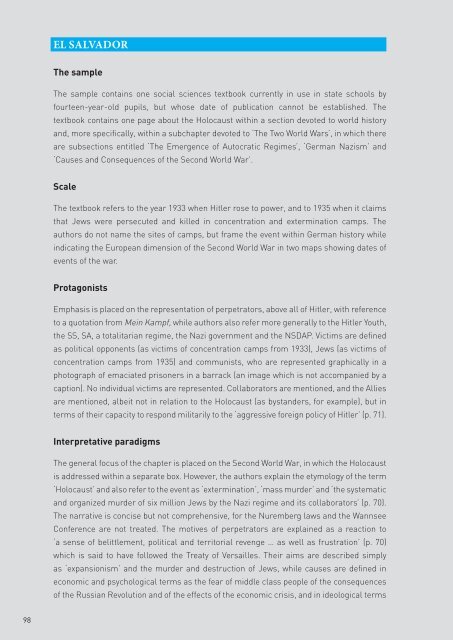228776e
228776e
228776e
Create successful ePaper yourself
Turn your PDF publications into a flip-book with our unique Google optimized e-Paper software.
EL SALVADOR<br />
The sample<br />
The sample contains one social sciences textbook currently in use in state schools by<br />
fourteen-year-old pupils, but whose date of publication cannot be established. The<br />
textbook contains one page about the Holocaust within a section devoted to world history<br />
and, more specifically, within a subchapter devoted to ‘The Two World Wars’, in which there<br />
are subsections entitled ‘The Emergence of Autocratic Regimes’, ‘German Nazism’ and<br />
‘Causes and Consequences of the Second World War’.<br />
Scale<br />
The textbook refers to the year 1933 when Hitler rose to power, and to 1935 when it claims<br />
that Jews were persecuted and killed in concentration and extermination camps. The<br />
authors do not name the sites of camps, but frame the event within German history while<br />
indicating the European dimension of the Second World War in two maps showing dates of<br />
events of the war.<br />
Protagonists<br />
Emphasis is placed on the representation of perpetrators, above all of Hitler, with reference<br />
to a quotation from Mein Kampf, while authors also refer more generally to the Hitler Youth,<br />
the SS, SA, a totalitarian regime, the Nazi government and the NSDAP. Victims are defined<br />
as political opponents (as victims of concentration camps from 1933), Jews (as victims of<br />
concentration camps from 1935) and communists, who are represented graphically in a<br />
photograph of emaciated prisoners in a barrack (an image which is not accompanied by a<br />
caption). No individual victims are represented. Collaborators are mentioned, and the Allies<br />
are mentioned, albeit not in relation to the Holocaust (as bystanders, for example), but in<br />
terms of their capacity to respond militarily to the ‘aggressive foreign policy of Hitler’ (p. 71).<br />
Interpretative paradigms<br />
The general focus of the chapter is placed on the Second World War, in which the Holocaust<br />
is addressed within a separate box. However, the authors explain the etymology of the term<br />
‘Holocaust’ and also refer to the event as ‘extermination’, ‘mass murder’ and ‘the systematic<br />
and organized murder of six million Jews by the Nazi regime and its collaborators’ (p. 70).<br />
The narrative is concise but not comprehensive, for the Nuremberg laws and the Wannsee<br />
Conference are not treated. The motives of perpetrators are explained as a reaction to<br />
‘a sense of belittlement, political and territorial revenge … as well as frustration’ (p. 70)<br />
which is said to have followed the Treaty of Versailles. Their aims are described simply<br />
as ‘expansionism’ and the murder and destruction of Jews, while causes are defined in<br />
economic and psychological terms as the fear of middle class people of the consequences<br />
of the Russian Revolution and of the effects of the economic crisis, and in ideological terms<br />
98




